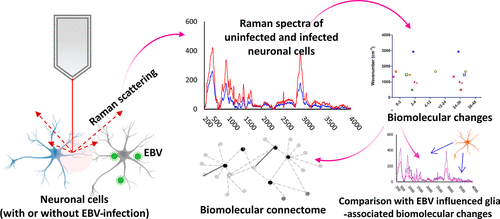Important Facts For Prelims
Biomolecular Alterations Post EPV Infection
- 12 Jul 2022
- 4 min read
Why in News?
Scientists have found that cancer-causing virus Epstein Barr Virus (EBV) can infect the neuronal cells and drive various changes in biomolecules.
- A researchers utilized the Raman Microspectroscopy Technique, under FIST (Fund for Improvement of S&T Infrastructure) scheme to explore the possible impacts of a cancer-causing virus on brain cells.
- Biomolecules are an organic molecule that includes carbohydrates, protein, lipids, and nucleic acids.
What is Raman microspectroscopy?
- Raman is a light scattering technique, whereby a molecule scatters incident light from a high intensity laser light source.
- Most of the scattered light is at the same wavelength (or color) as the laser source and does not provide useful information – this is called Rayleigh Scatter. However, a small amount of light (typically 0.0000001%) is scattered at different wavelengths (or colors), which depend on the chemical structure of the analyte – this is called Raman Scatter.
- Raman microspectroscopy is a vibrational spectroscopy technique used for investigating molecular fingerprints of a wide range of liquid or solid samples.
- The technique can be efficiently utilized to understand virus-mediated cellular changes and could provide valuable insights into specific biomolecular alterations.
What is EBV?
- EBV is a virus in the herpesvirus family that can infect humans.
- EBV virus has been found to be widely present in the human population. It usually does not cause any harm, but the virus gets reactivated inside the body in some unusual conditions like immunological stress or immunocompetence.
- This may further lead to various complications like a type of blood cancer called Burkitt’s lymphoma, stomach cancer, multiple sclerosis, and so on.
What are the Findings?
- It can change biomolecules such as fatty acids, carbohydrates, and protein components, leading to diseases of the central nervous system as well as brain cancer.
- Earlier studies provided links of EBV involvement in various neurodegenerative diseases. However, how this virus can affect the cells of brain and manipulate them is still unexplored.
- There may be timely and gradual changes in various biomolecules in the neuronal cells under viral influence.
- Additionally, these changes were distinct when compared to the changes observed in other supportive brain cells (that is, astrocyte and microglia).
- The lipid, cholesterol, proline, and glucose molecules are increased in the cells under viral influence.
- These biomolecular entities can ultimately play pivotal roles in the viral seizure of cells.
What is FIST Scheme?
- The “Fund for Improvement of S&T Infrastructure (FIST)” of the Department of Science & Technology (DST) is intended to provide basic infrastructure and enabling facilities for promoting R&D activities in new and emerging areas and attracting fresh talents in universities & other educational institutions.
- It is considered as complimentary support for enabling Departments/ Centres/ Schools/ Colleges to pursue research activities more effectively and efficiently.
- The current emphasis on the immensely successful FIST programme is for orienting it towards the goal of Atmanirbhar Bharat by providing accessibility of the R&D infrastructure facilities not only for research activities in academic organizations but also for use by the start-ups/ manufacturing industries/ MSMEs.
- The duration of support for each FIST Project is for a period not exceeding 5 years.





